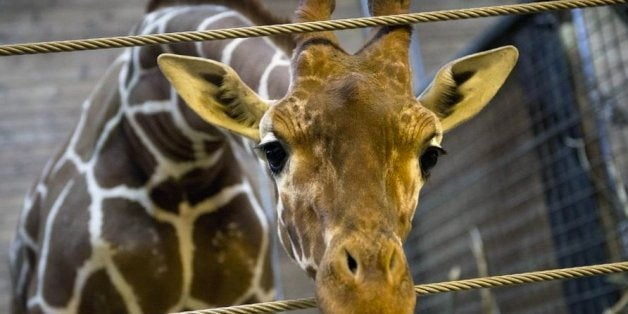
He was -- after all -- a Danish giraffe so it's no surprise that he loved rye bread. Lulled by a piece to make him to wander away from the pack, Marius unwittingly walked to his death. The 18-month animal stretched his neck and bowed his head to eat and that's when a zoo veterinarian shot him with a slaughterhouse bolt gun. Marius was then dissected in an open air, public three-hour educational lesson in giraffe anatomy.
Because of social media, a collective gasp was heard around the world as the Internet burned with outrage. It seems that hearts were broken when we witnessed the keepers at the Copenhagen Zoo break their trust with Marius.
"He should never have died so young and at the hands of his caretakers," writes Science correspondent, Virginia Morel, "the very ones who should have done all they could to protect him."
The raison d'etre of zoos is conservation, i.e., the protection and maintenance of endangered species. Zookeepers and animal park professionals throughout the world face the same critical issues: capacity and health. There are the only two methods available: contraception and euthanasia. Which one they choose depends on their culture.
In the United States, the choice is contraception. Chimps take human birth control pills, giraffes are served hormones in their feed, and grizzly bears have slow-releasing hormones implanted in their forelegs.
Cheryl Asa, who directs the Association of Zoos and Aquariums' Wildlife Contraception Center at the St. Louis Zoo, said euthanasia is not a comfortable fit for Americans. "On an emotional level, I can't imagine doing it and I can't imagine our culture accepting it," she said.
But in Denmark, zookeepers would rather euthanize redundant offspring after they mature than deny the animal parents the experience of procreating and nurturing their young. Nature and natural are words you hear.
"We'd rather they have as natural behavior as possible," said the now infamous Bengt Holst, director of conservation for the Copenhagen Zoo. "We have already taken away their predatory and anti-predatory behaviors. If we take away their parenting behavior, they haven't much left."
International guidelines on the ethics of breeding zoo animals have been difficult to draft because these philosophies are contradictory. In general, Europeans -- though certainly not all of them -- generally allow animals to raise their young until an age at which they would naturally separate from parents. Then the ones that do not fit into the zoo's breeding plans are systematically put down.
Cold? Callous? Or maybe just an ethnocentric misunderstanding?
In a rush to defend Copenhagen Zoo, Lesley Dickie, Executive Director of The European Association of Zoos and Aquaria (EAZA) admitted that it is not standard practice for some zoos and that the outrage over Marius can be attributed to a misunderstanding about what is "normal in Danish Culture."
Can generalizations about Danish culture contribute to this discussion? Is it even possible to unpack one of Europe's Scandinavian cultures by making superficial observations? After living here for 23 years as an ex-pat American, I'll take a chance.
To begin with, Denmark is a nation of farmers and as one would expect with farmers, they have a rather unsentimental attitude about animals. This mind-set continues to influence attitudes because very few contemporary Danes, no matter where they live, are more than one generation away from the farm. So an animal is likely never to be more than an animal.
Danes are certainly not indifferent to an animal's welfare, however. Indeed, not. Ironically, it is a deep and abiding concern about quality of life that makes Danish zookeepers reject contraception. Although highly debatable inside scientific circles, Danish zookeepers accept the conclusions of research that claim contraception is harmful to animals, capable of causing side effects and pathology such as cancer and other diseases.
To continue, Danes are a nation of realists and they respect nature -- make that Nature with a capital. Adolescent girls are permitted to get oral contraception without their parents' permission. If contraception fails, medical abortion is easily available. Exposing naked female breasts of sun-bathers on beaches or in city parks is nothing to talk about. Natural childbirth is not the business of doctors but of highly trained midwives who teach women to accept excruciating pain as part of the natural procedure.
Parallel to their respect for Nature, is a deeply rooted irreverence. Danes make fun of everybody. They value equality and decentralized authority and are not inclined to be deferential to anyone who attempts to behave with assumed superiority. I think this explains why they didn't return phone calls from the Yorkshire Wildlife Park in England that was ready to take Marius. All offers to intervene from them and many others -- in Holland, Sweden and the U.S. -- were undoubtedly interpreted as judgmental criticism.
Having said all that, however, I still have a few questions for Dr. Holst. One is an easy question for which he will undoubtedly have an answer. Why is the Copenhagen Zoo breeding reticulated giraffes, (Giraffa camelopardalis reticulata), when they are not endangered in the wild?
My second question is more difficult. And I sincerely ask it in good faith.
I have two granddaughters, cousins that will soon be 10 years old. These bright, wonderful little girls are sensitive and loving. Had I taken them to Copenhagen Zoo to meet baby Marius when he was born in 2012, they would have been enthralled. And then on subsequent visits as he was getting older, already knowing him, they would have looked for him.
Tell me, Dr. Holst: What could I have possibly said to them to make Marius's death and
public dissection an educational experience?
